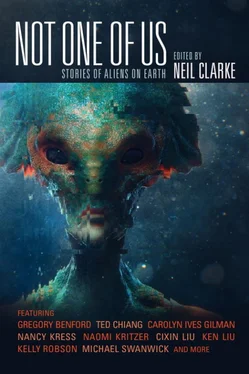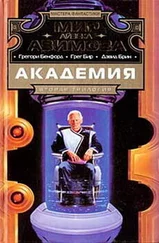Loss and displacement aside, the most difficult thing that first year was coping with the apparent limits of the translator. Although the quality improved, there were always gaps where a lengthy period of attempted communication resulted in a disappointingly blunt “cannot translate,” or worse, absolute silence.
Despite his plant-like appearance, it soon became apparent that the alien was not botanical in nature, nor bird, reptile, fish, or mammal or anything else he could compare it to on Earth. Obviously there was a cybernetic component, whether attached or integrated Tom couldn’t say.
Of more practical concern was that Tom had nothing to call him—and he didn’t want to use some disrespectful coinage or ‘pet’ name. Nor could he determine where the alien was from, or even the name of the van-like contraption they used to travel around together on the surface of a transformed Earth.
Tom understood that he was still in St. Louis, Missouri, but nothing was recognizable. Quakes and floods had distorted the town’s profile, and the fact that the suspension facility where he’d been found had been relatively intact was, in the translator’s terms, “an unlikely reality.” The alien said the area was “architecture in recombination with landscape,” a complexly ridged, sculptural field of debris and trash split by a narrow stream that was a vastly diminished and relocated Mississippi River.
The Gateway Arch was gone as well, and the companion had acquired a video so that Tom could watch in awe as the keystone failed and dropped out, the disconnected legs twisting away and falling in opposite directions, the translator narrating the analysis in an annoyingly detached, analytical monotone.
But at least Tom was finally allowed to drive the van. He stood before the segmented dashboard, his hands on the sections as the companion had demonstrated, maneuvering over the broken landscape. Despite having fewer appendages than the controls had been designed for, he was still able to make turns and stops, in most directions, just more slowly. Each day they returned to a predetermined location the companion picked via some untranslatable criteria.
As they came over the final rise from the lab, the clean, geometric lines of the excavation fields were clearly distinguishable from the muddle of destruction. It looked like a typical archaeological dig, he supposed, not having ever been on one during his own lifetime. (He’d have to stop thinking that way—it wasn’t as if he’d died.)
Eight or nine aliens traveled their particular areas of the field, trailed by assistants like himself intent on the debris at their feet—picking things up, examining them, recording the scene, stealing glances at the others, but keeping on task. He supposed a lucky alien might unfreeze an actual archaeologist to assist him. Otherwise he had to settle for, say, a high school history teacher.
The natives—the people indigenous to this time, smaller than Tom and the other assistants who’d been suspended—looked like children playing in the fields of debris. They climbed up and down the rubble, scrambling frantically over each other in their search for objects for survival or trade. At first he thought they were scavenging for food, but after having sifted through tons of debris himself he discovered there was almost nothing organic left in the ruins of the city.
A swollen version of the alien vans sped rapidly into the center of the dig. The natives surrounded it in an eye blink. A panel slid aside, disgorging dozens of green and brown packages. A swarm of natives hauled the parcels away like hungry insects. The aliens were feeding them.
From the patch directly in front of him, he picked up a small metallic jar and was looking at it when broad hands attached to skinny arms snatched it away. He had an impulse to chase after the native, who was now scrambling up a ridge, but thought better of it.
Angrily, he looked over at his companion for some help. A group of natives circled the alien as if he were some giant corn plant (extinct since Tom’s own era) and they worshippers anticipating his moves, interpreting what he considered worthy of his attentions.
No alien ever made a move to stop the natives, or even alter their path. Other than supplying food, the aliens ignored them. And Tom had to concede the natives deserved every liberty they could take. Manners had become a luxury.
He went back to work, picked up a piece of hammer, a bowl, a cupboard door, a jar rattling with something mummified inside. He catalogued, reported, added some objects to the stack they would take back to the lab. He still didn’t really know what they were looking for—the companion’s criteria had been untranslatable, so everything seemed of potential interest. Back at the lab he would study the recordings, flagging anything different from what they had seen before.
He found a telescoping handle with a bowl-like end closed with some sort of shutter. A visual record sent to the van came back as audio from his implant: “a device used for the capture and inspection of rat corpses. Decontaminated and safe to collect.” It was dated from after his time. The function of most unfamiliar objects he found was easier to guess—these were things made by human beings for human use, after all. People used tools, ate, bathed, and relieved themselves with generally recognizable equipment.
When he found an old plastic pull-toy, he began to speak of toys his father had made for him. Every day he made more of these sometimes stressful but highly addictive recorded narratives.
A rhythmic crunching noise surprised him.One of his fellow assistants was jogging across the debris field toward him. “The name’s Franklin!” the man shouted. “So, how long were you under?”
Tom’s companion swiveled toward the noise, but made no attempt to discourage this meeting. Franklin looked like an old man—like Tom did, he knew, suspension being less the fountain of youth than had probably been promised. Franklin was all skin and bone, but he moved with easy, un-self-conscious energy.
“Do you know when this is?” Tom asked eagerly.
Franklin laughed. “Sorry. No, I don’t think any of us do. ‘Cannot translate,’ which is what they say if there’s something they don’t want you to know.”
“I don’t think my companion would lie—I don’t think he even can .”
“But he can leave out the details, or say nothing at all. Surely he’s like all the other flowers in this petunia patch, and you get these long, silent, brooding spells?”
“Well, yes. But there’s no way for us to know what that silence actually means, or how it functions for them. They’re not plants, by the way.”
Franklin made a dismissive gesture with his hands. Or Tom thought it was dismissive—it had been a very long time since he’d actually witnessed a non-verbal human gesture. “Oh, I know. But you have to call them something , and they certainly look like plants. They look, well, they’re identical, aren’t they?”
Tom looked around and saw that his companion was now standing with Franklin’s. They were as motionless as… as houseplants. Perhaps they were watching, but Tom sensed it was more complicated than that. “Mine is bluer around the base above the filaments, and slightly less symmetrical. He feels—I don’t know—older than some of the others. They’re not identical at all—you just have to study them to recognize the differences.”
“I gather you call yours ‘the companion.’”
“That’s the way I think about him—it’s better than ‘the alien.’ But I don’t call him anything, at least when I speak to him. I just pretend I’m speaking to myself out loud.”
“I call mine Audrey . It makes the conversation go more easily, to have an actual name.”
Читать дальше








